Did you know that people in Kyrgyzstan use eagle hunting as a means to capture their prey?
Yes, you heard me right! During our 2-month travel in which we covered the city of Almaty in Kazakhstan, surrounding places, and Kyrgyzstan, we had the most amazing experiences. We stayed in yurts, indulged in the local cuisine, got involved in local activities, and a lot more.
And out of all those things, the most fascinating thing that we learned about is the practice of Eagle Hunting in Kyrgyzstan.
Of course, the chances of attending Salbuurun Eagle Hunting festivals can be slim but we were still able to catch a demonstration by the Salbuurun Federation.
The face of falconry in Kyrgyzstan, Salbuurun Federation is the best way to experience and learn about the ways of eagle hunting.
In this article, we will share all the details about this ancient tradition in Kyrgyzstan and how you can book a demonstration for yourself too.
Eagle Hunting in Kyrgyzstan
Ancient Tradition in Central Asia
Did you know the ancient tradition of eagle hunting was started in Central Asia?
The nomads who roamed around these lands in Central Asia started this tradition several thousand years ago. They tamed the eagles to acquire food and fur in the harsh winters and have passed on the tradition from one generation to the other.
Since this form of hunting is not necessary anymore for the survival of the people, the ancient tradition of eagle hunting is being slowly forgotten.
However, Kyrgyzstan is one of the few countries where this nomadic tradition is still followed by a few expert hunters.
Their main aim is to keep the tradition alive by using eagles to hunt for food. These expert hunters now compete in different festivals around Kyrgyzstan and Central Asia including the famous World Nomad Games and Salbuurun festival in Issyk Kul.
Why are Eagles Used for Hunting?
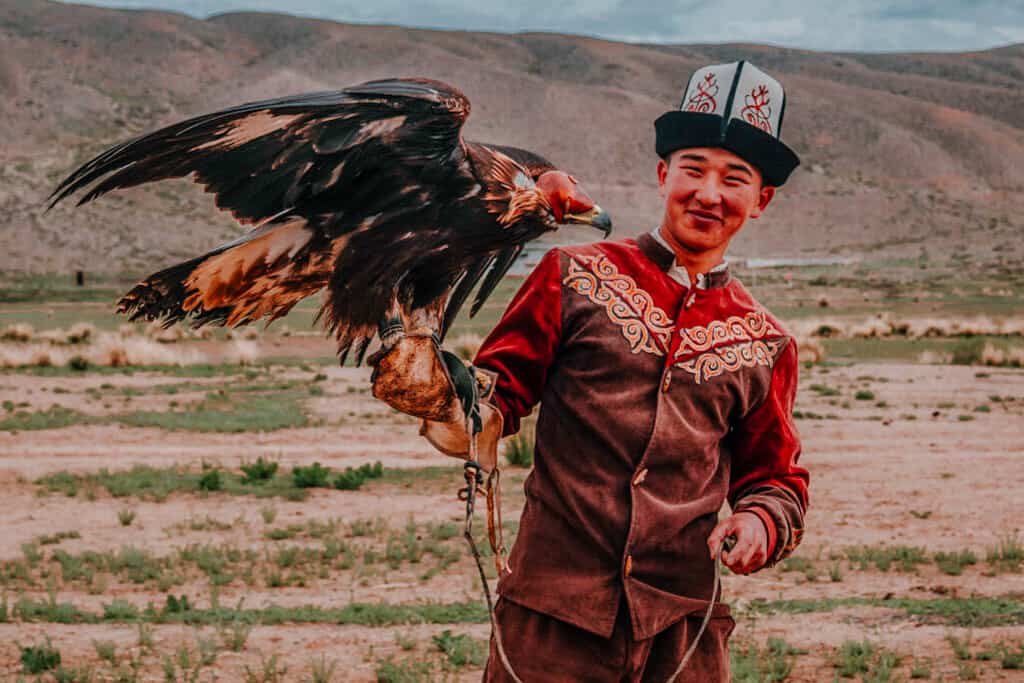
Kyrgyz people didn’t believe in using weapons to hunt animals for food. They believed in using hunting birds to kill the animals for food as it was more humane.
This method of hunting wild animals using a trained bird of prey is known as falconry. But while falconry is often associated with birds like falcons and hawks, Kyrgyz hunters felt these birds weren’t sharp and slightly amateurs.
So, they trained golden eagles and called them the bird of God. Eagles are found to be the most powerful, intelligent, and lethal hunters on earth. They are capable of killing all kinds of wild animals including foxes, wolves, and so on which is why Kyrgyz hunters preferred them.
In Kyrgyz, these golden eagles are called berkut due to the golden feathers that are present at the back of their heads. The Kyrgyz eagle hunters are known as berkutchi and are the guardians of the ancient tradition of hunting.
These expert eagle hunters have been well-respected in Kyrgyzstan society as earlier, hunting was a crucial part of nomadic life. And what’s more, they would provide food and fur for the entire village during the winter.
So, Kyrgyz eagle hunters were wealthy but they spent a lot of money on training and feeding these eagles too.
How are the Eagles Trained
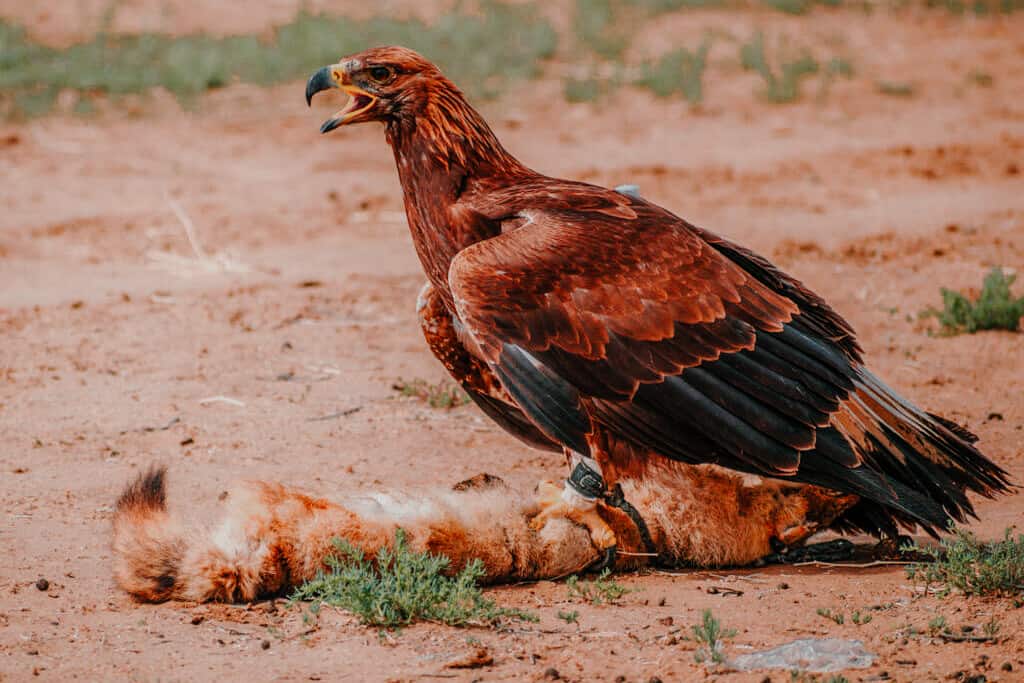
As mentioned earlier, the ancient tradition of eagle hunting has been passed down from generations, usually from a father to a son.
The eagle hunter training takes around 3 to 4 years before both the eagle and the trainer are ready. The eagle hunters in Kyrgyzstan are quite serious about this tradition and work hard for the training.
The training starts with the novice eagle hunter or berkutchi capturing an eagle or a fledgling from the wild. This is quite dangerous as eagles can easily kill the novices when they attempt to steal their fledgling or babies.
Once the eagle hunter procures an eaglet, he needs to spend his entire time with the bird. This way, the eaglet recognizes the hunter as his master and becomes dependent on him.
They shut the eyes of the eagle with a leather hood to prevent the bird from seeing during the daylight. That’s not all, the hunter also sings and talks to the bird so that it can learn the trainer’s voice.
The berkutchi is also responsible for feeding the eagle as this bonds them together.
The berkutchi uses a stuffed fox to train his eagle to hunt properly. This fox is usually tied to a rope so that it is not consumed by the eagle and can be used for training again.
Also, once the eagle hunts an animal and kills it, it is trained to fly back and sit down on the hand of the trainer.
What happens when the training is completed?
Once the training is complete, the berkutchi takes his eagle for the real hunting of animals. He wears a leather glove on his hands to carry the eagle and keeps the bird’s eyes shut until he sees a potential prey.
As soon as he spots a prey, he removes the hood from the eagle’s eyes and the eagle immediately flies to attack the animal. The eagle kills the animal in a single stroke by breaking the neck of the animal.
Since the eagle has been trained not to eat the kill, the bird will wait for the master to catch up. Later, the berkutchi gives the eagle a small portion of the kill as a reward. The rest of the kill is taken back to the village for food and fur.
When do they hunt?
Although there aren’t many eagle hunters in Kyrgyzstan anymore, the few which are there usually hunt during the winter season. This is known as the hunting season and it happens between late October and February end.
For the rest of the year, the eagle hunters need to spend at least 2 – 3 hours with their eagles lest the bird becomes wild and dangerous again.
How long do the Berkutchi and Eagle stay together?
Although there is no hard and fast rule, most eagle hunters stay with their pets for around 20 years and form a strong bond with them.
In these years, the eagle isn’t just a hunting partner or a means to an end but is a family member of berkutchi’s family. After 20 years, the berkutchi sets the eagle free to resume its life in the wilderness.
This is surely a tough call for most eagle hunters and it takes a few days for the eagle to revert to its wild habits.
However, this is how it is done by the hunters so that the population of free-living birds in the region stays sustained. This was particularly helpful when this tradition was commonly practiced all over Central Asia.
Where to See Eagle Hunting in Kyrgyzstan

Although this Kyrgyz nomadic tradition is not widespread anymore, there are a few eagle hunters still residing in the Issyk Kul region.
They are trying to keep this tradition alive and pass on the skills to the younger generation.
These eagle hunters are a part of the Salbuurun Federation who organizes festivals in Kyrgyzstan during the winter and fall seasons.
A few of these hunters work in association with the local tour guides where they organize a tour of Bokonbayevo village and showcase the eagles and their skills to the tourists.
If you wish to book this tour and learn more about this ancient tradition, then you can check contact Destination South Shore.
Website: https://southshorekg.com/
Email: [email protected]
Phone Number: +996 772 673 307 (Mobile and WhatsApp)
Salbuurun Demonstration Details
When you take this 1-hour day tour, here is everything that you will witness in a short time about the Kyrgyz culture.
Eagle Hunting Demonstration
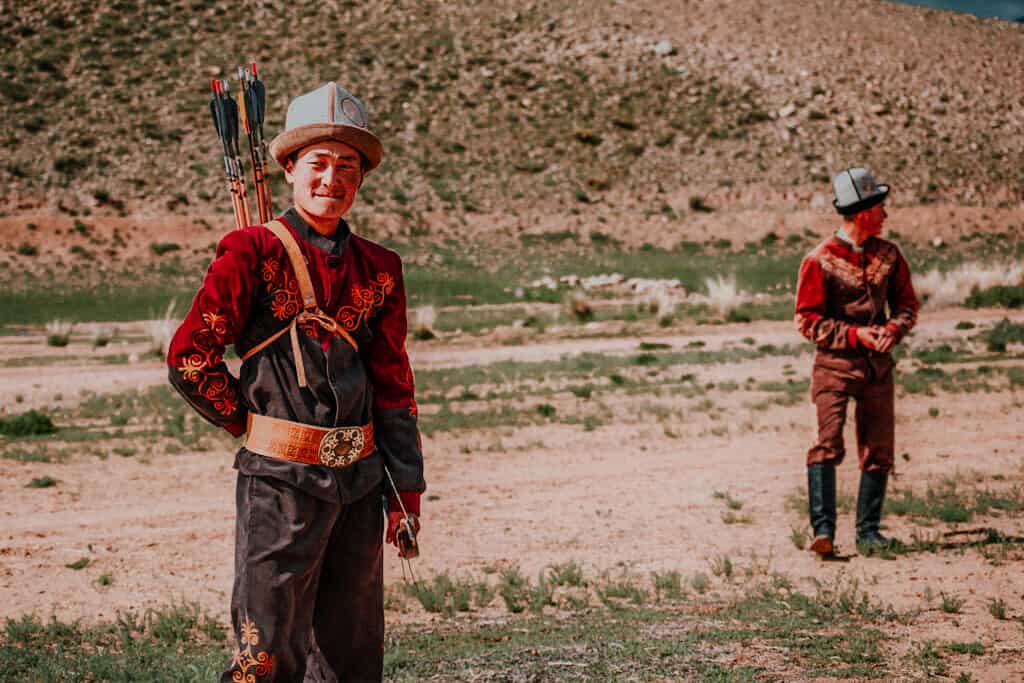
At the start, you will meet the eagle hunter who will guide you to an open field with a horse race track.
The golden eagles are safely kept in the hunter’s car and he brings the bird out to show how he trains the bird and then hunts the animals.
They will tell you the entire eagle training process and that eagles live 30 – 40 years. So, once he lets go of the eagle, it has half lifetime to live out in the wild.
They keep the hood on the eagle’s eyes the entire time to keep it calm until they demonstrate the hunting process.
And you also get a chance to hold the eagle which is quite heavy. It feels particularly intimidating when the eagle flaps its wings while being perched on your arm.
Once they have shared the training process and history of this tradition, one of the hunters walks to the top of a nearby hill with the two eagles.
After that, the eagle hunter gets a small piece of meat and gives a high-pitched call to the eagle whose hood has been now removed. The eagle instantly attacks the peace of meat and snacks on it.
They show it to you with a rabbit and a stuffed fox as well and it can be quite incredible(although a little scary) to watch.
Archery Demonstration
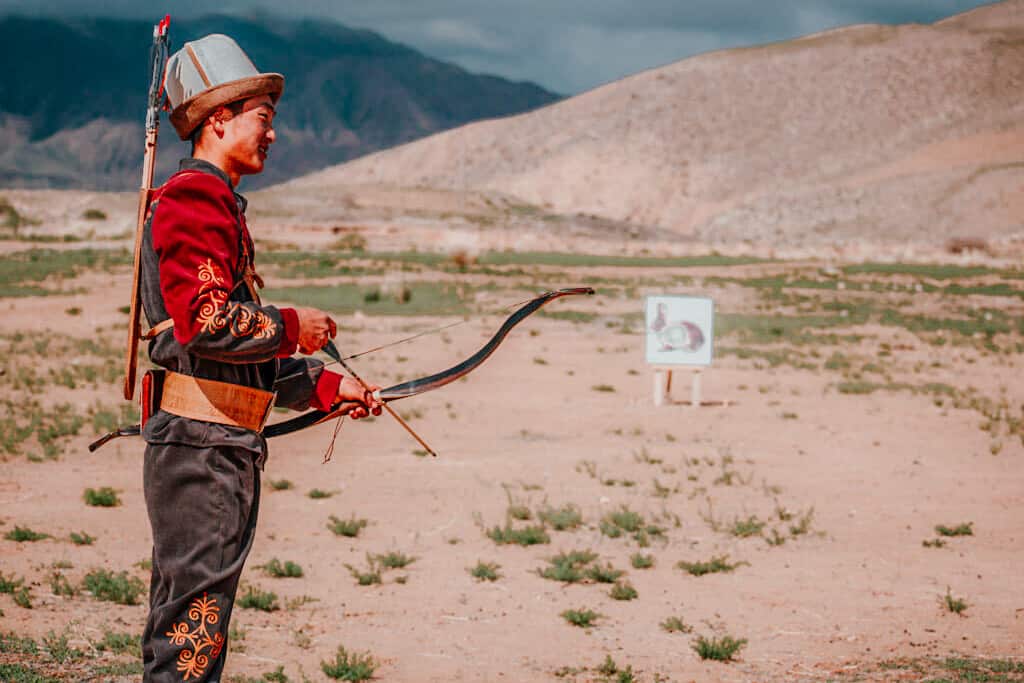
After the hunting demonstration, they move on to their horses to demonstrate their archery skills. The eagles’ eyes are covered again and they are places inside the car during this part of the demonstration.
Once they demonstrate their skills, they also give you a chance to try out archery over there and have a little fun.
Taigan Dogs Used in Hunting
Finally, you are shown the most prestigious breed in Kyrgyzstan, the Taigan. They are sighthounds that are used mainly for hunting and are adopted by the upper class to show how wealthy they are.
There are very few Taigan dogs (around 40) left in this country so it is a big deal to have one of these.
They demonstrate the hunting skills of this magnificent dog using a dead fox. The horseman pulls the dead fox along the back of the horse and the dogs start running behind it.
These dogs are bred to hunt so they are really fast and powerful and can easily catch their prey.
However, that doesn’t mean the dogs are scary or dangerous. In fact, they are quite adorable and friendly and have a soft wool coat. So, you will feel like caressing them and holding them close.
How to Reach Bokonbayevo
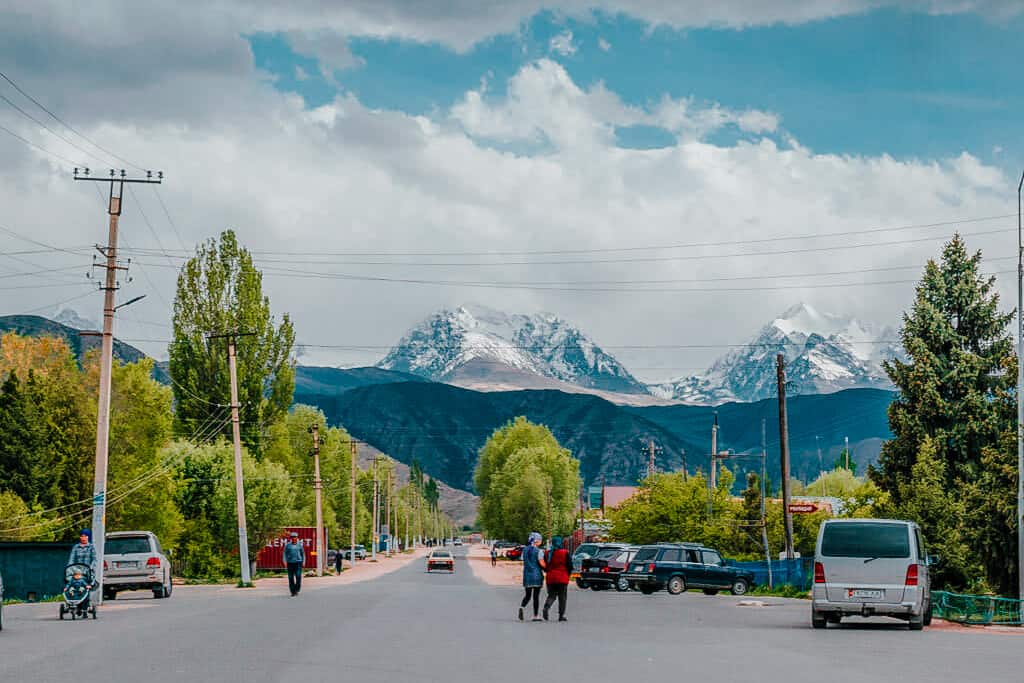
Since Bokonbayevo is comparatively a lesser-explored region by the tourists, you will need to reach a closer destination first such as Bishkek or Karakol.
Another option would be to make Bokonbayevo your base as there are several interesting sights around it for exploring such as Skazka Canyon, Jeti Oguz, Issyk Kul lake, and so on.
Here are a few popular modes of transportation that you can use to reach Bokonbayevo from different regions.
Marshrutka
One of the most popular modes of transportation in Kazakhstan and Kyrgyzstan, a marshrutka is a type of minivan that can fit several people at a time.
The marshrutkas are smaller than a bus but bigger than a taxi and are comfortable for both short and long journeys.
You can take a Marshrutka from Bishkek (Western Bus Station) or Karakol to reach Bokonbayevo. It will take 3-4 hours to reach from Bishkek and will cost around 250 INR.
There are multiple marshrutkas in a day that you can get after 30 – 60 minutes of waiting. From Karakol, you can get 4 marshrutkas at 12:20, 14:20, 15:20, and 16:30.
It takes around 2.5 hours to reach from Karakol and will cost around 120 INR.
Shared Taxi
There are also shared taxis from different regions to Bokonbayevo but these shared taxis only leave after they are full.
From Bishkek, you will find shared taxis throughout the day for 350 – 400 INR that will take 3 hours to reach. From Karakol, you can get shared taxis throughout the day for 200 – 250 INR and it will take around 2 hours to reach.
Night Bus
If you are looking for a more comfortable journey, then you can always take a night bus from Bishkek that leaves at 9:00 p.m. and takes 6 hours to reach Bokonbayevo.
This journey will cost you around 200 INR and you will get the bus ticket from the Western Bus Station.
Private Taxi
Finally, if you are short on time or don’t have a budget-constraint then you can hire a private taxi to reach Bokonbayevo. Ideally, it will cost you around 2000 – 4000 INR (4-seater) depending on where you start from.
Private taxis can be a little expensive so make sure you bargain the cost before hiring a taxi.
Where to Stay in Bokonbayevo

If you are planning to spend a night in Bokonbayevo so that you can explore this region, then don’t worry. There are a lot of options available here.
Yurt Camps
One of the best ways to make your stay in Kyrgyzstan memorable is by spending a night in a yurt camp around here. There are several yurt camps throughout Kyrgyzstan, especially in the Bokonbayevo region.
Personally, we stayed in the Bel Tam Yurt Camp that was located on the shore of Issyk Kul lake.
One of the best things about the Bel Tam yurt camp is that it is warm and cozy and a fusion of western and nomadic culture.
Here, you can choose to stay in a yurt camp and have access to hot water, eco-friendly toilets, showers, etc. So, you get to experience the nomadic culture while being comfortable.
Price: 850 INR/person for yurt stay and breakfast. 350 INR/person for a meal
There are several other yurt camps also available in this area that you can search.
Guest Houses and Hotels
Apart from yurt camps, you also have several guest houses and hotels in this region that will charge you around 2000 – 3500 INR for the night.
These accommodations are clean and safe and you can also get meals here for an extra cost. A few options to look out for are Aziza Guest House, Gulmira Guesthouse, Muras, Sherbet Guesthouse, and so on.
ATMs in Bokonbayevo
There are a few ATMs available in Bokonbayevo from where you can withdraw cash. However, make sure that you use an ATM that accepts VISA or Mastercard.
Also, since there are only 2-3 ATMs in this region, it would be advisable to withdraw cash from Bishkek itself to pay for your journey, stay, and activities in this region.
Mobile Network in Bokonbayevo
There is an intermittent network near the Issyk Kul lake region so you might have some troubling connecting to the Internet around here.
However, O! and Beeline do work splendidly in most regions of Kyrgyzstan so get those Sim cards while traveling this country.
Summary
We experienced this remarkable activity with Destination South Shore Tour and it was just out of the world.
The command that the hunters had over their eagles and the precision with which the eagle killed the animals was astounding. While it was not a pretty sight as the eagles can be a little scary, it was a great way to learn more about the Kyrgyz nomadic culture.
Also, the entire tour was of around 1 hour including the archery and horse riding demonstration so it was quite fun and well worth the money.
So, if you are planning a trip to Kyrgyzstan anytime soon, I would urge you to take this tour and learn how amazingly humans and nature can co-exist peacefully and sustainably.


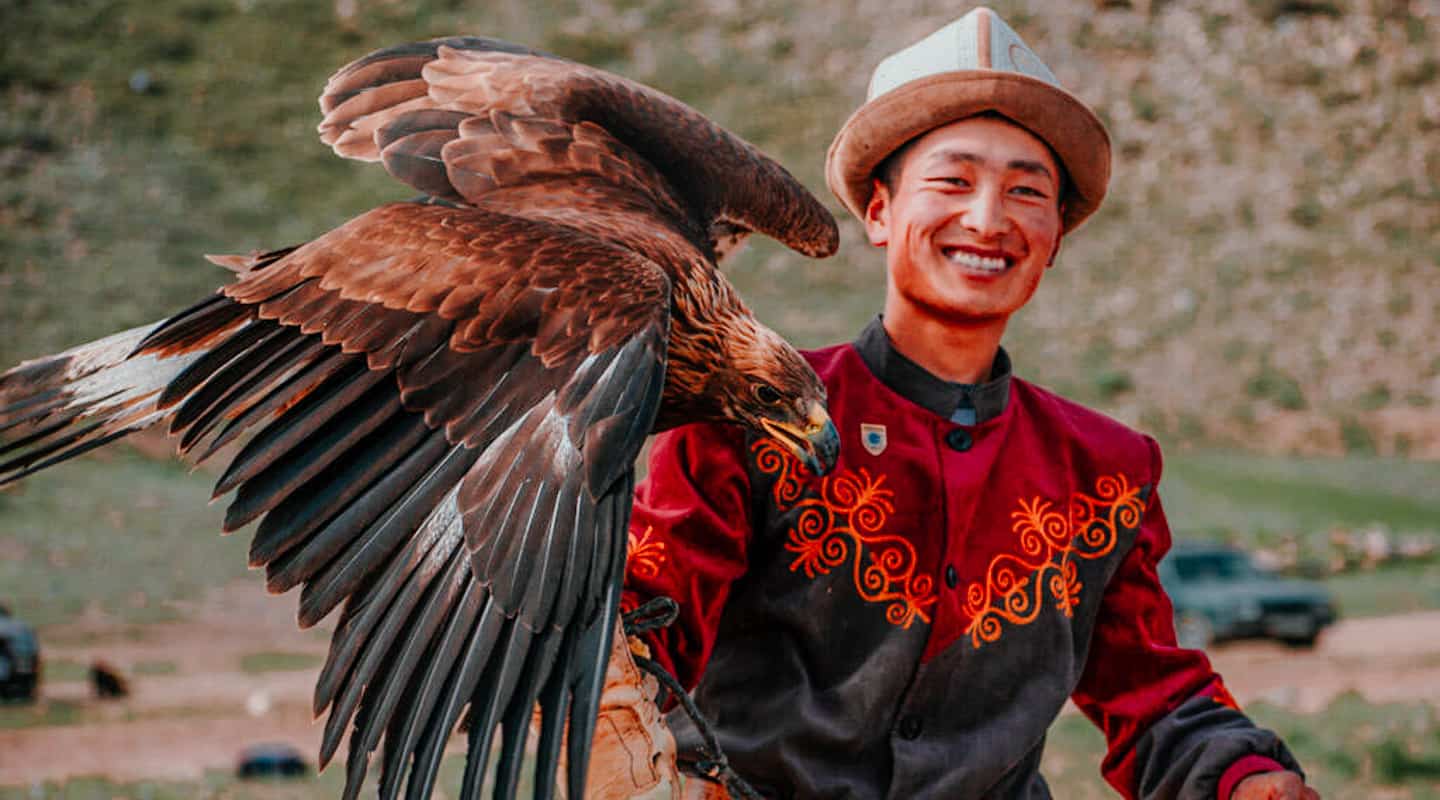

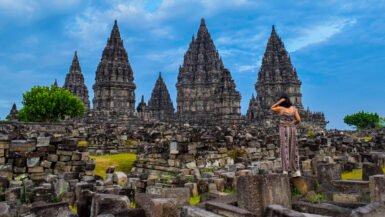

Leave a reply